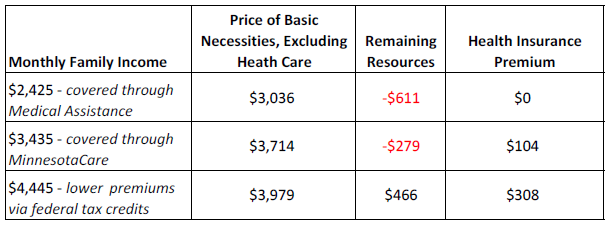Without assistance, many Minnesota families would be unable to afford health care. Even families with earnings well above the federal poverty line struggle to meet their basic needs before paying their health insurance premiums. Comparing monthly premiums with the cost of other necessities in a family’s budget puts the work of the Governor’s Health Care Financing Task Force in its most appropriate context.
I recently joined Children’s Defense Fund-Minnesota in presenting to two working groups of the Governor’s Health Care Financing Task Force. We combined data about the cost of health care with data about the price of other family essentials. Today, I’m writing about premiums — I’ll post about out-of-pocket costs next week.
Our presentation focused on three representative families. All three were made up of two adults, a two-year-old and a six-year-old, and lived in Ramsey County — the only difference was their incomes. For our analysis, we looked at families eligible for Medical Assistance, MinnesotaCare, or federal tax credits that can be used on MNsure, Minnesota’s health care exchange.
We used the Economic Stability Indicator, a tool maintained by Children’s Defense Fund-Minnesota, to calculate the costs faced by each family to meet their basic needs. The Indicator draws on a wide range of data to estimate the price of things like housing and food, and includes public supports that can reduce the burden of a family’s basic expenses.
The Indicator shows that for families qualifying for Medical Assistance and MinnesotaCare, the costs to meet their bare-bones needs are higher than their incomes. These families must make difficult choices just to keep a roof over their head and food in their fridge. MinnesotaCare and Medical Assistance help by keeping health insurance premiums for high-quality coverage at more affordable levels than these families would face on MNsure.
The Indicator also shows that families earning too much to qualify for MinnesotaCare or Medical Assistance still have very little wiggle room in their monthly budgets. The Advanced Premium Tax Credits created by the Affordable Care Act lower the monthly price of health coverage so that these families don’t experience increases in the insurance market that may otherwise bust their budget.

Source: Children’s Defense Fund-Minnesota, Economic Stability Indicator. Data is based on an updated, unpublished version of the Indicator. This presentation of the data excludes potential Section 8 Housing Assistance and Child Care Assistance due to very long waiting lists for both forms of assistance.
These numbers leave little room for interpretation. Even with incomes at more than twice the official poverty line, families have only a very small financial cushion after paying their subsidized health care premiums. The Health Care Financing Task Force should focus its efforts on ways to ensure that all Minnesota families can afford health care premiums as well as their other basic needs.
-Ben Horowitz